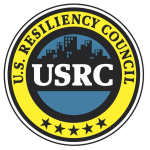A major recommendation of the Oregon Resilience Plan was the establishment of resilience ratings for building and communities. The idea was to let people and communities know how well a particular building, structure or community would perform in the Cascadia Earthquake. The goal was to help people make informed decisions about the acceptable level of risk. These rating systems are now being to appear. The United States Resiliency Council (USRC) is releasing its Building Resilience Rating System this fall. The rating system is completed and the USRC are now in the process of recruiting structural engineers to become certified to perform the rating system. Their rating system has three components: Safety, Cost of Repairs, and Time to Regain Function. Depending on performance, a building will get ratings from one star to five star. Similar to a LEED Rating, this information will be shown on a placard at the entrance to the building. Rather than the abstract “building meets code” you will know if loss of life is likely or not, up to a standard whether even injuries are unlikely. For repair costs, you will know if costs are in a range of less than 5% of the cost to replace the building up to or over 40%. For when you could expect to reuse the building, the ratings range from hours, to days, to weeks, to months to over a year. Like the LEED system, the goal is introduce market forces into seismic resilience. Currently, the seismic performance of buildings, even in places like California, doesn’t necessarily translate in the rents or sale of buildings.
While the USRC Building Rating system currently focusses on seismic resilience, the goal is to expand it to include other other natural hazards. A sustainability component is in the works as well. A fourth category, Energy and Carbon Consequences, is being studied by FEMA, that will allow this rating system to tie directly into sustainability goals.
 The community rating system are not as advanced as they are for buildings, but they are appearing. The most impressive effort has been from OBP. Their first foray (with the help of Hack Oregon and others) was the Aftershock app in which you can look up your address and find out the level of shaking you can expect, along with the time frame of your community’s recovery and how to prepare. It is a pretty large-grained effort based on the data used for the Oregon Resilience Plan, but it easy to use and gives people the big picture. To this, OPB has added a similar app called Schools and Hospitals At Risk, which follows a similar format and allows to see the vulnerabilities of your local schools and hospitals. There is also an app embedded in their article about the vulnerabilities of Oregon’s bridges “Half Of Oregon’s Critical Bridges Could Collapse in Quake” that lets you look at each bridge in western Oregon. For the moment there is not a methodology that allows a ranking system like the one for buildings, but it does get the information out there in an understandable way.
The community rating system are not as advanced as they are for buildings, but they are appearing. The most impressive effort has been from OBP. Their first foray (with the help of Hack Oregon and others) was the Aftershock app in which you can look up your address and find out the level of shaking you can expect, along with the time frame of your community’s recovery and how to prepare. It is a pretty large-grained effort based on the data used for the Oregon Resilience Plan, but it easy to use and gives people the big picture. To this, OPB has added a similar app called Schools and Hospitals At Risk, which follows a similar format and allows to see the vulnerabilities of your local schools and hospitals. There is also an app embedded in their article about the vulnerabilities of Oregon’s bridges “Half Of Oregon’s Critical Bridges Could Collapse in Quake” that lets you look at each bridge in western Oregon. For the moment there is not a methodology that allows a ranking system like the one for buildings, but it does get the information out there in an understandable way.
This proto-community rating system has been part of OPB’s greater effort, Unprepared, that has been looking at Oregon’s lack of preparedness to a Cascadia earthquake. Their effort and collaboration with the “hack” community of taking big data and transforming it into useful and accessible information offers an alternative method to that used by the USRC that is particularly adapted for community resilience.

